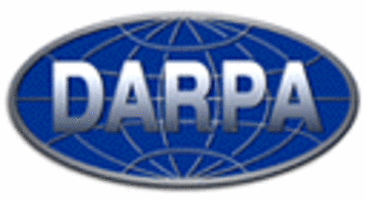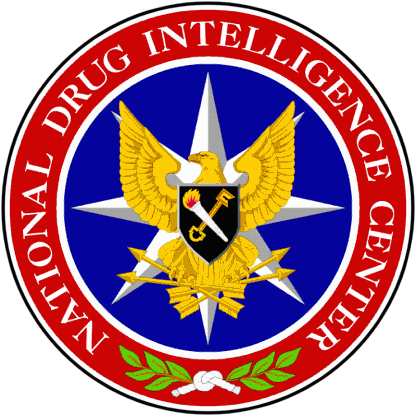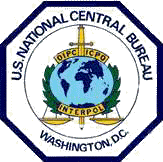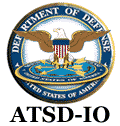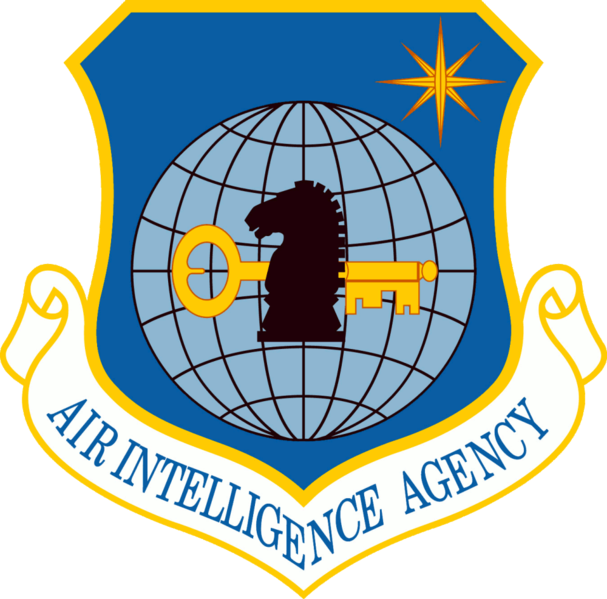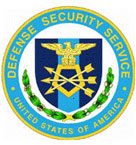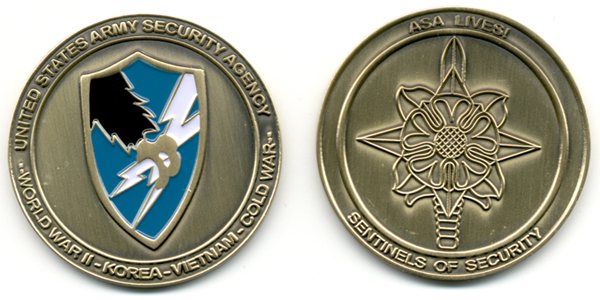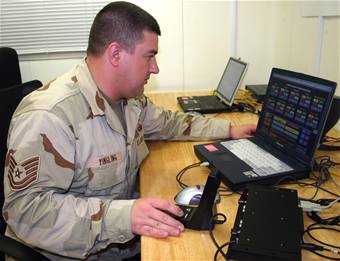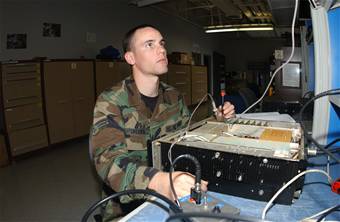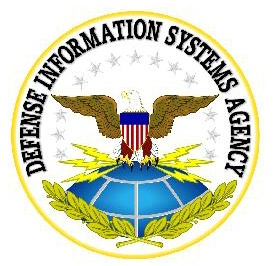|
Intelligence Gathering |
||
|
Information Gathering and Other Offices Page Two |
||
U.S. Air Force Office of Special Investigations The Air Force Office of Special Investigations was founded Aug. 1, 1948. Secretary of the Air Force W. Stuart Symington created AFOSI and appointed Special Agent Joseph Carroll, an assistant to FBI Director J. Edgar Hoover, as the first AFOSI commander and charged him with providing independent, unbiased and centrally directed investigations of criminal activity in the Air Force. AFOSI provides professional investigative service to commanders of all Air Force activities. AFOSI identifies, investigates and neutralizes criminal, terrorist, and espionage threats to Air Force and Department of Defense personnel and resources. |
||
Defense Advanced Research Projects Agency (DARPA) The Defense Advanced Research Projects Agency (DARPA) is the central research and development organization for the Department of Defense (DoD). It manages and directs selected basic and applied research and development projects for DoD, and pursues research and technology where risk and payoff are both very high and where success may provide dramatic advances for traditional military roles and missions. |
||
National Security Council (NSC) Since the end of World War II, each administration has sought to develop and perfect a reliable set of executive institutions to manage national security policy. Each President has tried to avoid the problems and deficiencies of his predecessors' efforts and install a policy-making and coordination system that reflected his personal management style. The National Security Council (NSC) has been at the center of this foreign policy coordination system, but it has changed many times to conform with the needs and inclinations of each succeeding chief executive. The National Security Act of July 26, 1947, created the National Security Council under the chairmanship of the President, with the Secretaries of State and Defense as its key members, to coordinate foreign policy and defense policy, and to reconcile diplomatic and military commitments and requirements. This major legislation also provided for a Secretary of Defense, a National Military Establishment, Central Intelligence Agency, and National Security Resources Board. The view that the NSC had been created to coordinate political and military questions quickly gave way to the understanding that the NSC existed to serve the President alone. The view that the Council's role was to foster collegiality among departments also gave way to the need by successive Presidents to use the Council as a means of controlling and managing competing departments. |
||
Information Access Division (IAD) About IAD The Information Access Division (IAD), part of NIST 's Information Technology Laboratory , provides measurements and standards to advance technologies dealing with access to multimedia and other complex information. |
||
President's Foreign Intelligence Advisory Board (PFIAB) Introduction The President's Foreign Intelligence Advisory Board (PFIAB) provides advice to the President concerning the quality and adequacy of intelligence collection, of analysis and estimates, of counterintelligence, and of other intelligence activities. The PFIAB, through its Intelligence Oversight Board, also advises the President on the legality of foreign intelligence activities. The PFIAB currently has 16 members selected from among distinguished citizens outside the government who are qualified on the basis of achievement, experience, independence, and integrity. The Role of The Board Unique within the government, the PFIAB traditionally has been tasked with providing the President with an independent source of advice on the effectiveness with which the intelligence community is meeting the nation's intelligence needs and the vigor and insight with which the community plans for the future. The History Of The Board The Board was established in 1956 by President Eisenhower and was originally called the President's Board of Consultants on Foreign Intelligence Activities. It gained its current name under President Kennedy and it has served all Presidents since that time except for President Carter. A record of chairpersons is available. |
||
Information Security Oversight Office (ISOO) The Information Security Oversight Office (ISOO) is responsible to the President for policy and oversight of the Government-wide security classification system and the National Industrial Security Program. We receive our authority from Executive Orders 12958 "Classified National Security Information" [PDF] and 12829 "National Industrial Security Program" [PDF], as amended. We are a component of the National Archives and Records Administration (NARA) and receive our policy and program guidance from the National Security Council (NSC). ISOO has two directorates and a staff of 25 people to accomplish its mission. |
||
National Drug Intelligence Center (NDIC) Established in 1993, the National Drug Intelligence Center (NDIC) is a component of the U.S. Department of Justice and a member of the Intelligence Community. The General Counterdrug Intelligence Plan, signed by the President in February 2000, designated NDIC as the nation's principal center for strategic domestic counterdrug intelligence. |
||
US National Central Bureau of INTERPOL (USNCB) U. S. Department of Justice USNCB Accessibility Notice The USNCB CAN NOT provide investigative assistance to private citizens and non-law enforcement sources. Private citizens and non-law enforcement sources must contact their local, state or federal law enforcement agency with information or requests for assistance. This internet site shall not be used to submit requests for investigative assistance. For official business with USNCB, please write to:
(202) 616-9000 Phone
|
||
Assistant to the Secretary of
Defense for Intelligence Oversight
Welcome to our home page. This site is intended to help all Department of Defense (DoD) intelligence organizations and personnel understand Intelligence Oversight and the role that our office plays in this area. Also, it provides information for anyone interested in understanding the precautions that the DoD takes to ensure that its intelligence* activities are carried out in ways that do not infringe on the constitutional rights of U.S. persons. The duties and obligations placed on DoD intelligence organizations to protect the rights of individuals stem from the U.S. Constitution, Presidential Executive Order 12333, and DoD Regulation 5240.1-R which spells out how the Presidential Executive Order applies to Defense intelligence activities. DoD Regulation 5240.1-R outlines the DoD Intelligence Oversight program and serves as the basis for the DoD regulations and instructions that implement Intelligence Oversight in the Military Services, Combatant Commands, and DoD intelligence agencies. The office of the Assistant to the Secretary of Defense for Intelligence Oversight (ATSD (IO)) is an independent organization reporting to the Secretary and Deputy Secretary of Defense, and is responsible to the Secretary and Deputy Secretary for ensuring that Intelligence Oversight policies and regulations are carried out by DoD organizations that perform intelligence functions. To this end, we conduct inspections and investigations to ensure that all activities performed by intelligence units and personnel are conducted in accordance with federal law, Presidential Executive Orders, DoD directives, regulations, policies, standards of conduct, and propriety. The Inspector General organizations of the military services, Defense intelligence agencies, and combatant commands also inspect for compliance regarding intelligence oversight and report their findings to the ATSD (IO) quarterly. Our charter can be found at DoD Directive 5148.11. |
||
Office of Terrorism and Financial Intelligence (TFI) Mission The Office of Terrorism and Financial Intelligence (TFI) marshals the department's intelligence and enforcement functions with the twin aims of safeguarding the financial system against illicit use and combating rogue nations, terrorist facilitators, weapons of mass destruction (WMD) proliferators, money launderers, drug kingpins, and other national security threats. |
||
Air Intelligence Agency (AIA) The Air Intelligence Agency realigned as a primary subordinate unit under the Air Force's Air Combat Command (ACC) on February 1, 2001. Under the realignment, the 67th Information Operations Wing and 690th Information Operations Group at Kelly AFB, and the 70th Intelligence Wing at Fort Meade, Md., fall directly under ACC’s 8th Air Force, headquartered at Barksdale AFB, La. AIA’s three centers, the National Air Intelligence Center, Wright-Patterson AFB, Ohio; the Air Force Information Warfare Center at Kelly; and the Air Force Technical Applications Center, an administratively supported unit at Patrick AFB, Fla., will continue to be aligned under AIA headquarters. http://www.fas.org/irp/agency/aia/index.html http://usmilitary.about.com/library/milinfo/affacts/blairintelligenceagency.htm |
||
Defense Security Service (DSS) The Defense Security Service (DSS) is an agency of the Department of Defense (DoD) located in Alexandria, Virginia with field offices throughout the United States. The Under Secretary of Defense for Intelligence provides authority, direction and control over DSS. DSS provides the military services, Defense Agencies, 23 federal agencies and approximately 12,000 cleared contractor facilities with security support services. DSS Vision DSS is the premier provider of personnel and industrial security services in the Department of Defense, improving the security of our nation and its warfighters. PSCD returns The Protecting Secret and Confidential Documents (PSCD) independent study course and exam are now available through the DSS Academy's ENROL system. |
||
Text Retrieval Conference (TREC) The TREC Conference series is co-sponsored by the National Institute of Standards and Technology (NIST) Information Technology Laboratory's (ITL) Retrieval Group of the Information Access Division (IAD) and the Advanced Research and Development Activity (ARDA) of the U.S. Department of Defense. |
||
US Army Security Agency (ASA) The U.S. Army has supported its fighting forces with signals intelligence since World War I. The first permanent organization to do this was established in 1930 as the Signal Intelligence Service. During World War II, the SIS (renamed the Signal Security Service in 1943 and later the Signal Security Agency - SSA) exploited the communications of both Germany and Japan, shortening the war and saving many thousands of American lives. The SSA was reorganized as the Army Security Agency (ASA) at Arlington Hall Station, Virginia, on 15 September 1945. Operating under the command of the Director of Military Intelligence, the new agency had a sweeping charter. It exercised control functions through a vertical command structure. ASA established a worldwide chain of fixed sites - "field stations" - while maintaining large theater headquarters in the Far East and in Europe. In 1949, all three military cryptologic services were centralized under the new Armed Forces Security Agency (AFSA), the precursor of today's National Security Agency. ASA transferred most members of its large civilian headquarters staff to AFSA in this process. However, because of the need once again to support troops in actual combat in the Korean War, ASA again expanded, deploying tactical units on a large scale to support the Army in combat. For the first time, ASA grew to include groups and battalions in its force structure. |
||
Defense Information Systems Agency (DISA) DISN Data Services For More Information: Phone - NIPRNet
Phone - SIPRNet
The Defense Information System Network (DISN) provides interoperable, secure Internet Protocol (IP) data communications services. NIPRNet: The Unclassified but Sensitive Internet Protocol (IP) Router Network (formerly called the Non-Classified Internet Protocol Router Network (NIPRNet)) is a global long-haul IP based network to support unclassified IP data communications services for combat support applications to the Department of Defense (DoD), Joint Chiefs of Staff (JS), Military Departments (MILDEPS), and Combatant Commands (COCOM). Provide seamless interoperability IP services to customers with access data rates ranging from 56KB to 1.0GB via direct connections to a NIPRNet router, remote dial-up services (56KB), services to the Tactical community via ITSDN/STEP sites, and access to the Internet. SIPRNet: The Secret IP Router
Network (SIPRNet) is DoD’s largest interoperable command and control
data network, supporting the Global Command and Control
System (GCCS), the Defense Message System
(DMS), collaborative planning and numerous other classified warfighter
applications. Direct connection data rates range from 56 kbps to 155Mbps.
Remote dial-up services are available up to 19.2kbps.
* NIPRNet service manager at (703)
882-0158, DSN 381
http://www.disa.mil/
Related Links: |
||
|
About ICON Portal: ICON is a Knowledge Management tool that enables Intelligence soldiers all over the world to communicate, collaborate and investigate. It hosts discussion forums, serves as a single point of entry to get to USAIC and other Intelligence Community websites, and hosts a variety of public and private web applications that support the Intelligence Community. In order to ensure that ICON continues to meet your needs, we encourage you to provide us with feedback.
DoD SIPRNET Portal http://nic.mil |
||
DDN Network Information Center (NIC) INTRODUCTION The NIC Internet Hostname Server is a TCP-based host information program and protocol running on the SRI-NIC machine. It is one of a series of internet name services maintained by the DDN Network Information Center (NIC) at SRI International on behalf of the Defense Communications Agency (DCA). The function of this particular server is to deliver machine-readable name/address information describing networks, gateways, hosts, and eventually domains, within the internet environment. As currently implemented, the server provides the information outlined in the DoD Internet Host Table Specification [See RFC-952]. For a discussion of future developments see also RFC-921 concerning the Domain Name System. PROTOCOL To access this server from a program, establish a TCP connection to port 101 (decimal) at the service host, SRI-NIC.ARPA (26.0.0.73 or 10.0.0.51). Send the information request (a single line), and read the resulting response. The connection is closed by the server upon completion of the response, so only one request can be made for each connection. DOD INTERNET HOST TABLE SPECIFICATION http://www.nic.mil/
|
||
| Joint Worldwide Intelligence
Communications System (JWICS)
The Joint Worldwide Intelligence Communications System (JWICS pronounced jaywicks) is a system of interconnected computer networks used by the U.S. Department of Defense and the U.S. Department of State to transmit classified information (up to and including information classified TOP SECRET and SCI) by packet switching over the TCP/IP protocols in a secure environment. It also provides services such as hypertext documents and electronic mail. In other words, the JWICS is the DoD’s classified version of the civilian Internet together with its counterpart, the SIPRNet. JWICS superseded the earlier DSNET2 and DSNET3, the Top Secret and SCI levels of the Defense Data Network based on ARPANET technology. Joint Worldwide Intelligence Communications System (JWICS) Primary Purpose: Provide a transmission path capable of secure video/data within defense intelligence community. At T1 speed allows:
Equipment Requirements: JWICS hardware is self-contained. Requires 120/60 power. Connectivity Requirements: T1 (1.544 mbps) pathway, usually satellite. Often used in conjunction with TROJAN SPIRIT. (1.024 mbps for VTC (2 X 512kbps), .384 mbps designated for data, .136 mbps for serial data channels and system control). Crypto Requirements: KY96/KG-194/KIV-7 Normal Locations: Over 150 fixed sites to include all major commands. Ten JMICS available for contingency/crisis response (maintained at DIA). Approximately 20 containerized JWICS available for contingency/crisis response. Information Managed: Point to point and multi-point secure VTC service. Broadcast and video programming of Defense Intelligence Network. Bulk data transfer of a variety of network services. Products Created: This is a communications path. Products are produced by systems on this path. Lead Service/Contractor: Defense Intelligence Agency. Current Fielding Status: Operational; planning in progress to increase mobile JWICS assets. Asynchronous Transfer Mode (ATM) multicast is under development to allow an unlimited number of receivers and a limited number of transmitters to participate in a JWICS command brief outside of a JWICS conference room. Known Problems: Slow data rates can result in poor VTC. DIICOE Compliance Rating: N/A Point of Contact: Mr. Tom Moslener, Deputy Directorate- Crisis Operations (J203), Joint Staff, DSN: 223-7640; JWICS Help Desk: Comm: (202) 231-4000, DSN 428-4000; JWICS Systems Requirements Management Division, Comm: (703) 695-1999, DSN: 225-1999. MCIA Det, Comm: (703) 784-6111 DSN: 278-6111. Updated by: Capt J. F. Moffatt, USMC, CCSC-01 SOURCE: Global Security |
||
Joint Worldwide Intelligence
Communications System (JWICS)
JWICS is the IC global backbone network for the DoDIIS communications network. It provides DoD and IC users a mature, reliable, and flexible SCI communications architecture. The Marine Corps JWICS program provides a variety of IT HW/SW that supports network functionality, high-speed/cytological bandwidth for transmission of data, text, graphics, imagery and video, and VTC. The program also provides over a 1000 MOS 02XX and 26XX intelligence members with the computer HW/SW/peripherals required to perform intelligence activities at the SCI level, contractual support for accreditation of equipment installation levied by DIA. Additionally, the program funds for the continual refresh of technological advances to network, HW/SW and peripherals. The JWICS provides garrison and tactical intelligence capabilities and infrastructure SCI to Major Commands, MSCs, and permits point-to-point or multipoint intelligence exchange throughout the entire Marine Corps and the DoD IC. http://www.marcorsyscom.usmc.mil/sites/cins/INTEL/SIGNINIT/JWICS.html#sd |
||
Radio over Internet Protocol Routed Network (RIPRNet) Radio over Internet Protocol Routed Network (RIPRNet) is a United States military network that allows users to exchange radio voice data over an IP routed network. In 2007, RIPRNet is still being installed in Iraq for use by US and Coalition forces. It is a Tactical System, used by trucks or mobile forces. Part of the network is routed over Strategic systems to increase connectivity. As of July 2007, 14 core sites and 37 ground station consoles were operational, costing "less than $10 million (US dollars) to implement, and is expected to cost 300,000 a year to maintain." http://en.wikipedia.org/wiki/RIPRNet
Related Links: |
||
Global Command and Control System
(GCCS)
GCCS is an automated information system designed to support situational awareness and deliberate and crisis planning with the use of an integrated set of analytic tools and flexible data transfer capabilities. GCCS will be the single C4I system to support the warfighter from the foxhole to the command post. JITC's Role Under the Joint Interoperability Certification role, and as mandated by CJCSI 6212.01, The Joint Interoperability Test Command (JITC) tests and certifies the interoperability of C4I systems for Joint use. In that role, JITC plans, conducts, and certifies the interoperability of GCCS with all its required interfaces or interfacing systems. * Being an independent operational
test and evaluation/assessor of DISA, and other DoD C4I acquisitions Identifying
and solving Command, Control, Communications, Computers and Intelligence
(C4I) and Combat Support Systems interoperability deficiencies
JITC will be the preeminent information systems evaluator, reducing risk to the warfighter by providing value-added process and product evaluations, operational assessments, and technical assistance throughout the life cycle of DoD Systems. GCCS IOP Points of Contact IOP Certification Test Director
IOP Certification Test Manager/Leader
|
||
| Global Command and Control System
(GCCS)
Global Command and Control System (GCCS), often pronounced "GEEKS" by the Air Force, Army and Navy, "GUCKS" by the Marines and in DISA spelled out G-C-C-S) is a system of Command, Control, Communications, Computers, and Intelligence (C4I) systems and applications. Although GCCS is the Department of Defense (DOD) Command and Control (C2) system of record, there are GCCS variants fielded by the US Army (GCCS-A), the US Air Force (GCCS-AF), and the US Navy/Marine Corps (GCCS-M) and Joint Command Centers (GCCS-J) . GCCS was developed to replace the Worldwide Military Command and Control System (WWMCCS). GCCS is an automated system designed to support situational awareness, crisis action planning and other mission areas, and is intended to be the C4I system that supports military personnel from the foxhole to the command post. GCCS provides tools to support the Command Process. The GCCS Family of Systems is on a "migration path." For a time, the term Joint Command and Control (JC2) was in use. More recently the Defense Department chose the term Net-Enabled Command and Control (NECC) as the destination for all current and future tools and applications. As of late 2007, all three terms (GCCS, JC2 and NECC) are in use, often without reference to the relationship between them. Command Process The joint command and control process consists of maintaining situational awareness, planning and execution. Maintaining situational awareness requires a number of steps. A collection plan must be maintained and sensors must be tasked. Data must be collected and processed. The data then needs to be analyzed and interpreted. The situation must be assessed. The information then needs to be tailored and disseminated. Planning takes the information developed by situational awareness and puts it to use. Options are developed. Courses of action are evaluated, selected and recommended. Plans and directives are developed. Re-planning is done as the situation changes. The plan is then executed. Execution is assessed. Re-planning is done as needed. Situational awareness is used to monitor the outcome of the plan, completing a turn of the command process wheel. Applications GCCS includes applications supporting the mission areas of situational awareness, deployment planning, force readiness and intelligence. The Integrated C4I System Framework (ICSF) primarily supports situational awareness and provides reachback capability to other data sources. The Joint Operations Planning and Execution System (JOPES) supports the deployment planning, execution and sustainment mission area. Along with these applications, GCCS supports collaboration using chat systems, newsgroups and email. Connectivity GCCS uses classified portions of the Defense Information Systems Network (DISN) for connectivity. Tactical networks, as well as other types of circuits such as Officer in Tactical Command Information Exchange Subsystem (OTCIXS) and Tactical Data Information Exchange Subsystem (TADIXS) are used to extend the reach of GCCS to the field. Variants The GCCS family of systems has a variant defined for each branch of the United States armed forces. GCCS-A The Global Command and Control System-Army (GCCS-A) is the United States Army's Strategic and Theater Command and Control (C2) System. It provides readiness, planning, mobilization and deployment capability information for the strategic commanders. For Theater commanders, GCCS-A provides Common Operational Picture (COP) and associated friendly and enemy status information, force employment planning and execution tools (receipt of forces, staging, intra-theater planning, readiness, force tracking, onward movement, and execution status), and overall interoperability with Joint, Coalition and the tactical Army Battle Command Systems (ABCS). GCCS-A's stated mission is to provide automated command and control tools for Army Strategic and Theater Commanders to enhance warfighter capabilities throughout the spectrum of conflict during joint and combined operations in support of the National Command Authority. An integral part of a coordinated Department of Defense (DoD) and Joint Technical Architecture-Army, GCCS-A provides information support to all levels of military command across a Common Operating Environment (COE). Primary sites GCCS-A supports or will support include: ARCENT, EUCOM, FORSCOM, HQDA, MTMC, SOUTHCOM, USAREUR, USARPAC, USARSO GCCS-M The Global Command and Control System – Maritime GCCS-M AN/USQ-119E(V) previously the Joint Maritime Command Information System (JMCIS), is the United States Navy's primary fielded Command and Control System. The nomenclature AN/USQ-119(V) and AN/USQ-119A through D refer to older versions of the Navy Tactical Command System Afloat (NTCS-A) and JMCIS. The objective of the GCCS-M program is to satisfy Fleet Command, Control, Communications, Computers, and Intelligence (C4I) requirements through the rapid and efficient development and fielding of C4I capability. GCCS-M enhances the operational commander’s warfighting capability and aids in the decision-making process by receiving, retrieving, and displaying information relative to the current tactical situation. GCCS-M receives, processes, displays, and manages data on the readiness of neutral, friendly, and hostile forces in order to execute the full range of Navy missions (e.g., strategic deterrence, sea control, power projection, etc.) in near-real-time via external communication channels, local area networks (LANs) and direct interfaces with other systems. The GCCS-M system is comprised of four main variants, Ashore, Afloat, Tactical/Mobile and Multi-Level Security (MLS) that together provide command and control information to warfighters in all naval environments. GCCS-M provides centrally-managed C4I services to the Fleet allowing both United States and allied maritime forces the ability to operate in network-centric warfare operations. GCCS-M is organized to support three different force environments: Afloat, Ashore and Tactical/Mobile. Afloat configurations can be categorized as force-level and unit-level configurations. Ashore configurations of GCCS-M are located in fixed site Fleet and Tactical command centers as well as mobile rapid deploy command centers such as MICFACs, mobile command facilities designed to provide the Commander, Joint Tactical Forces (CJTF) with similar C4I capabilities when forward-deployed ashore. In order to allow for maximum interoperability among GCCS systems at all sites and activities (Afloat, Ashore and Tactical/Mobile), GCCS-M utilizes common communications media to the maximum extent possible. The Secure Internet Protocol Router Network (SIPRNET), Non-Secure Internet Protocol Router Network (NIPRNET) and the Joint Worldwide Intelligence Communications System (JWICS) provide the necessary Wide Area Network (WAN) connectivity. JMCOMS will provide the WAN connectivity for the Afloat and Tactical/Mobile GCCS-M systems. Operating "system–high" at the Secret and SCI security levels, both networks use the same protocols as the Internet. In addition to the SIPRNET operating at Secret/SCI security levels, GCCS-T supports collaborative planning at the National Command Authority (NCA) level by providing Top Secret connectivity to a limited number of sites. OPLANS developed at NCA level can then be downgraded to secret for dissemination using SIPRNET. GCCS-M has been implemented traditionally on high-performance UNIX workstations because, until recently, only these platforms were powerful enough to run GCCS-M software. However, with the exponential increase in processing capability of the Intel PC processor family and the maturity of the Windows NT and Java / Web multi-user operating systems, migrating GCCS-M to the PC environment is a very practical and logical decision. Once designed for the PC environment, GCCS-M becomes largely hardware independent, meaning that it uses almost all existing hardware platforms: UNIX, Wintel, Macintosh, etc. GCCS-M intends to incrementally migrate GCCS-M segments to both the Windows NT and JAVA / Web environments. GCCS has already replaced the Honeywell computers and associated peripheral equipment used by the Worldwide Military Command and Control System (WWMCCS) in those major command centers that had WWMCCS installations. The full implementation of GCCS and GCCS-M will include more sites than the former WWMCCS sites, and in general these installations will include installation of new hardware to existing C4I systems or upgrading the hardware of existing systems to meet IT-21 and Defense Information Infrastructure Common Operating Environment (DII COE) requirements. The key to understanding GCCS and GCCS-M is that they are principally sets of integrated software applications which will operate on DII COE hardware. During the transition from UNIX servers to Windows NT servers these software applications replace older versions and continue to run using most of the same hardware and network infrastructure already in place, allowing for phased introduction of new hardware. GCCS-AF From The JC2 project justification (PDF): GCCS-AF FoS consists of the following programs (each with their own program elements): TBMCS Force Level (TBMCS-FL), Joint Defensive Planner (JDP), Time Critical Targeting Functionality (TCT-F), Joint Targeting Toolkit (JTT), GCCS-AF Infrastructure (GCCS-AF I), Deliberate Crisis Action Planning and Execution Segment (DCAPES) and the C2 portion of the Joint Environmental Toolkit (JET). GCCS-J From DISA's description of GCCS-J: GCCS-J is primarily an integration program and the GCCS-J PMO develops limited mission capabilities in-house. GCCS-J integrates Service and Agency developed mission applications/functional capabilities that are delivered to the joint community. It is the mission applications/functional capabilities, integrated together with the core infrastructure that provide a joint C2 capability supporting the following mission areas: Force Employment, Force Readiness, Force Sustainment, Force Projection (Planning and Deployment/ Redeployment), Force Protection, Situational Awareness, Intelligence, and Cross-Functional/Infrastructure. (See Below) http://en.wikipedia.org/wiki/Global_Command_and_Control_System |
||
Global Command & Control System - Joint (GCCS-J) Introduction GCCS-J is the DOD joint C2 system of record for achieving full spectrum dominance. It enhances information superiority and supports the operational concepts of full-dimensional protection and precision engagement. GCCS-J is the principal foundation for dominant battlespace awareness, providing an integrated, near real-time picture of the battlespace necessary to conduct joint and multinational operations. It fuses select C2 capabilities into a comprehensive, interoperable system by exchanging imagery, intelligence, status of forces, and planning information. GCCS-J offers vital connectivity to the systems the joint warfighter uses to plan, execute, and manage military operations. GCCS-J is a Command, Control, Communications, Computer, and Intelligence (C4I) system, consisting of hardware, software, procedures, standards, and interfaces that provide a robust, seamless C2 capability. The system uses the Defense Information Systems Network (DISN) and must work over tactical communication systems to ensure connectivity with deployed forces in the tactical environment. The GCCS-J operational environment consists of multiple strategic server and local enclaves operating separate technical baselines (strategic server and global baselines) as a single virtual system. Fielded under the Joint Staff Strategic Server Policy, dated 6 December 2001, Strategic Servers are enterprise mission capabilities fielded for the benefit of the entire community, under the control of DISA.1 Current GCCS-J Strategic Servers include Global Combat Support System (Combatant Command/Joint Task Force) (GCSS (CC/JTF)), JOPES, and Status of Resources and Training System (SORTS). All technical baselines are subject to the same rigorous development, testing, and accreditation processes. The GCCS-J Strategic Servers enable timelier fielding of enhanced capabilities to the user community. GCCS-J employs a predominantly open system client/server architecture, which is evolving to an n-tier web service-based architecture that allows a diverse group of commercial-off-the-shelf (COTS) and government-off-the-shelf (GOTS) software packages to operate at any GCCS-J location. Built upon the Common Operating Environment (COE), GCCS-J integrates C2 mission applications/capabilities, database, web technology, and office automation tools. The COE is supplemented with additional C2 unique common services and applications called GCCS-J Common Core, collectively known as the Infrastructure. The Infrastructure serves as the foundation upon which Service and Agency developed mission applications/functional capabilities are integrated across multiple mission areas. The GCCS-J core infrastructure includes the Integrated C4I System Framework (ICSF) that provides data communications, fusion, and display needs, enabling a full Personal Computer (PC) client. The infrastructure provides Directory Services, Enterprise Management, Web Services, Collaboration Services, and Security Services to include anti-viral and encryption software. The architecture is constructed so that GCCS-J interfaces with external systems, providing easy access to information from the Services, Agencies, and other national assets. GCCS-J is primarily an integration program and the GCCS-J PMO develops limited mission capabilities in-house. GCCS-J integrates Service and Agency developed mission applications/functional capabilities that are delivered to the joint community. It is the mission applications/functional capabilities, integrated together with the core infrastructure that provide a joint C2 capability supporting the following mission areas: Force Employment, Force Readiness, Force Sustainment, Force Projection (Planning and Deployment/ Redeployment), Force Protection, Situational Awareness, Intelligence, and Cross-Functional/Infrastructure. Contact Information: (703) 882-1224
|
||
| World Wide Military Command
and Control System(WWMCCS)
The World Wide Military Command and Control System (or WWMCCS) was a military command and control system implemented for the command and control of the United States military. It was created in the days following the Cuban Missile Crisis. WWMCCS (pronounced "wimex") was a system of systems that encompassed the elements of warning, communications, data collection and processing, executive decision making tools and supporting facilities. It was decommissioned in 1996. Computer Hardware:
The Air Force Systems Command’s Electronic Systems Division awarded a fixed-price, fixed-quantity contract to Honeywell Information Systems, Inc. for 46 million dollars on 15 October 1971. The contract included 35 Honeywell 6000 series systems, some having multiple processors. System models from the H-6060 through the H-6080 were acquired. They ran a specially secured variant of Honeywell’s General Comprehensive Operating Supervisor (GCOS), and for years the vendor maintained and enhanced both the commercial GCOS and the "WWMCCS" GCOS in parallel. Network:
The Joint Chiefs of Staff issued JCS Memorandum 593-71, "Research, Development, Test, and Evaluation Program in Support of the Worldwide Military Command and Control Standard System." in September of 1971. The joint chief memorandum proposed what they called a Prototype WWMCCS Intercomputer Network (PWIN) pronounced as pee-win. The PWIN was created to test the operational benefits of networking WWMCCS. If the prototype proved successful, it would provide a baseline for an operational network. PWIN included three sites at the Pentagon, Reston, Virginia and Norfolk, Virginia. The sites included Honeywell H6000 computers, Datanet 355 front end processors and local computer terminals for system users. Connections were provided for remote terminals using microwave, cable, satellite, or landline connections. Honeywell H716 computers, used as an interface message processors (IMP) provided packet switching to network the PWIN sites together. The TELNET protocol was made available to the WWMCCS community for the first time to access remote sites. The PWIN network was based on experience gained from ARPANET. The first comprehensive test plan for PWIN was approved on 29 October 1973. On 4 September 1974, the Joint Chiefs recommended that the prototype network be expanded from three sites to six. The recommendation was approved on 4 December 1974. The new sites included the Alternate National Military Command Center; the Military Airlift Command at Scott AFB; and the US Readiness Command headquarters at MacDill AFB. Testing was conducted in 1976, called Experiment 1 and Experiment 2. Experiment 1, held in September took a crisis scenario borrowed from a previous exercise. Experiment 1 provided a controlled environment to test PWIN. Experiment 2 was held in October, during an exercise called Elegant Eagle 76'. Experiment two was less controlled, so as to provide information about PWIN being able to handle user demands during a crisis. The results of the experiments were mixed. Another test called Prime Target 77 was conducted during the spring of 1977. It added two new sites and had even more problems than Experiment 1 and Experiment 2. Ultimately, operational requirements trumped the problems and development of an operational network was recommended during 1977. The Joint Chiefs of Staff approved PWIN’s operational requirements on 18 July 1977. PWIN expanded to include a number of other WWMCCS sites and become an operational WWMCCS Intercomputer Network (WIN). References:
|
||
Defense Research and Engineering Network (DREN) The Defense Research and Engineering Network (DREN) is DoD's recognized research and engineering network. The DREN is a robust, high-capacity, low-latency nation-wide network that provides connectivity between and among the HPCMP's geographically dispersed High Performance Computing (HPC) user sites, HPC Centers, and other networks. The DREN Wide Area Networking (WAN) capability is provided under a commercial contract. The DREN WAN service provider has built DREN as a virtual private network based on its commercial infrastructure. The DREN provides digital, imaging, video, and audio data transfer services between defined service delivery points (SDPs). SDPs are specified in terms of WAN bandwidth access, supported network protocols [Multi Protocol Label Switching, Internet Protocol (IP), Asynchronous Transfer Mode (ATM)], and local connection interfaces. DREN currently supports both IP version 4 (IPv4) and IP version 6 (IPv6) at bandwidths from DS-3 (45 Mbps) at user sites up to OC-48c (2.488Gbps) at selected HPC Centers. Future bandwidths will scale even higher. Expansions or enhancements to the DREN as a whole are accomplished through the addition of defined SDPs or modifications to the operating specifications of existing SDPs. The sites connected by DREN services may be at virtually any location in the continental United States, including Alaska and Hawaii, and at OCONUS sites. Incorporating the best operational capabilities of both the DoD and the commercial telecommunications infrastructure, DREN is the official DoD long-haul network for computational scientific research, engineering, and testing in support of DoD's S&T and T&E communities. It has also been designated as a DoD IPv6 pilot network by the Assistant Secretary of Defense (Networks & Information Integration)/DoD Chief Information Officer [ASD (NII)/DoD CIO]. DREN enables over 4,300 scientists and engineers at DoD and other government laboratories, test centers, universities, and industrial locations to use HPCMP computing resources. Since its inception, DREN has been very active in transferring leading edge network and security technologies across DoD and other federal agencies. Since users and resources are scattered throughout the United States, strong interconnectivity with other major networks and high performance test beds at key interconnect points are critical for optimal use of DoD HPC resources. |
||
U.S. Global Information Grid (GIG) The Global Information Grid (GIG) is an all-encompassing communications project of the United States Department of Defense. It is defined as the globally interconnected, end-to-end set of information capabilities, associated processes, and personnel for collecting, processing, storing, disseminating, and managing information on demand to warfighters, policymakers, and support personnel. The GIG includes all owned and leased communications and computing systems and services, software (including applications), system data, security services, and other associated services necessary to achieve information superiority for the United States military. It is the physical manifestation of the network-centric warfare doctrine. The GIG was envisioned by the Department of Defense Chief Information Officer on September 22, 1999 and was officially mandated by an overarching directive from the Deputy Secretary of Defense on September 19, 2002. Noteworthy progress has been made since then. Although the lofty objective of the Global Information Grid has not yet been realized, computer-enabled communication between soldiers and commanders in the battlefield have been successful, most notably during the 2003 invasion of Iraq. This ability is considered an early GIG component. |
||
Global Information Grid (GIG) The GIG Vision
"…[We must] leverage information
technology and innovative network-centric concepts of operations to develop
increasingly capable joint forces. Our ability to leverage the power of
information and networks will be key to our success…"
The Global Information Grid (GIG) vision implies a fundamental shift in information management, communication, and assurance. The GIG system will provide authorized users with a seamless, secure, and interconnected information environment, meeting real-time and near real-time needs of both the warfighter and the business user. The GIG will use commercial technologies augmented to meet DoD's mission-critical user requirements. If your company provides an IA or IA-enabled product or service and you are interested in scheduling a capabilities presentation with the IAD, please complete the Capabilities Presentation Questionnaire. |
||
| Originally posted by StargateSG7
PREVIOUS POSTER'S QUOTE: "You cannot access the SIPRNET without being allowed on the network. There is no way for you (or anyone else here) to access the SIPR side without the specialized equipment and access to either the sat signal, a secured phone, or physical connections." Hmmm....I can tell you're either quite young...i.e. less than 30 years old or you don't know enough about the low-level hardware protocols and/or electrical engineering. I am assuming your computer systems are TEMPEST certified, because if they aren't, I can think of 50 ways to get in.... 1) Fibre Optic Cable Assemblies: Single Mode and Multimode fibre can be spliced into with repeater hardware and protocol analyzers so that I can intercept the base level ATM/SONET packet data. Packets that are encrypted can be run through various algorithms to obtain Most-Probable-Key ranges so that. even Triple-AES (768 bit) encryption is vulnerable to differential analysis and probable text-form analysis to ontain HASH values and valid key ranges. Fibre-Optic systems that are "Secured" have Nitrogen or other Inert Gas injected into the cable housing designed to prevent such splicing and interceptionby allowing sensors to identify gas-pressurizatioin changes during a cable splice operaton. HOWEVER I can put a "Clean Box" around my splice location that is ALSO Nitrogen/Inert Gas infused and pressurized to the same level so that I can perform splicing undetected. I can also ground out the surrounding mesh weave of a fibre optic cable into an electrical bypass so that ANOTHER splice detection method is foiled. 2) 10/100/1000 megabit Ethernet RJ 45 /Cat 5 & 6 cables I can simply use inductance to intercept low-level packets or can also INJECT my own packet streams such as Ping or TraceErt requests that I can re-intercept to FIND servers or dissassemble Kerberos and/or other Key Exchange packets.. These I'll use to break in to any server. 3) Cisco/Nortel Routers can be pinpointed and have their routing management service accounts compromised by simple social engineering attacks or even using simple electrical interference to reset them back to their original specs and then I'll upload my own BIOS which will prevent router shaping & packet transport analysis so that I can walk in at will intercepting and duplicating packets which will be send to my off-site packet sniffers. 4) Graphics Cards have Drivers on both Secured Linux & Windows systems so I can digitally sign the drivers that I create and the next time the BIOS or graphics drivers are updated, I'll have Ring-0 privileges and then I can walk across the OS as I please. I can do the same thing by using Wake-on-Lan or other built-in "Doors" to flash my own signed BIOS/Drivers into Network Cards, Firewire Cards, USB interfaces, etc and then get Ring-0 privileges to walk anywhere in the system to intercept, duplicate or re-direct disk writes, graphics card updates or packet send/receives as I see fit! 5) I have some other VERY SNEAKY methods which basically cannot be defended against using standard security
protocols simply because they attack the base underlying hardware
thatis common to ALL computer systems no matter where
they are in the world, even IF you use encryption. And if you
spooks want to know about those methods you'll just have to email
me or send me a U2U message.
6) The poster of the above quote is quite mistaken that a smart card will protect your data, since the social networks that create the requirements for their use can be infiltrated and of course the base hardware can be atacked even IF the systems are TEMPEST certified simply because the original designers of the hardware never envisioned the lengths some of us will go to get information. quote][i]Originally posted by StargateSG7[/i] CONTINUED FORM ABOVE: 7) Using Real-Mode BIOS Interrupt 13 and Interrupt 26 to directly read & write hard drive sectors...If any of you know what that statement means then YOU ARE truly knowledgeable.....or just old......I can change Windows protected mode disk reads & writes and stop the CPU for a Real-Mode tasks such INTR-13 & 26 without Interference from the OS and write data to flash memory or Hidden sectors for later retrieval. 8) Grid-based encryption breaking algorithms that use
differential
analysis and probable content scanning to break
the encryption NO MATTER its key-length...Since I generally know the
TYPE of data you're sending
I can get the actual content by analysing for
commonalities so that
I can narrow my Encryp/Decryp key ranges
down to a manageable level. Depending upon the algorithms used (Not always AES/DES) I can visually graph the key values and resulting encrypted streams against random data and common text or visual data streams so that I can use my own Visual Cortex (or data mining software) to see the colour coded visual patterns that indicate which possible key ranges could be used to decrypt the recorded data stream Example:" Keyhole/Trumpet/Mentor series USAF/NSA/NRO satellites (also called "Birds") have ground stations in the Virginias, Carolinas, Pine Gap, Ft. Meade, Utah, A-51, etc. and the format of this image data is generally known within the Spook world. ....SO What we do is...... The birds send images to the ground stations using non-repeating keys that are changed every use and since many use spread-spectrum communications to do so, this allows me to NARROW my search down because the very idea of spread spectrum commlinks requires discrete and KNOWN methods to encode data which I can use to my advantage when intercepting and decrypting those communications. Because I know WHERE and WHEN data is sent/received, I can figure out WHAT is sent and then work from there. If I can use an audio card and a common antenna to intercept NOAA satellite images, I can assure you that encrypted commlinks over spread spectrum can ALSO be decrypted MUCH EASIER that the spooks think simply by taking advantage of discrete mathematics and Grid-based processing power. And since they're using the onboard clocks to synchronize the keys changes I can PREDICT the next possible range of keys if a pseudo-random number generator is being used. If your RAND-NUM generator is truly random, then the task is much more difficult but NOT impossible because a key cange command SOMEHOW has to be synchronized on at least one side and then sent to the other and THAT operation can be sniffed out of thin air..... SO DON'T use a single method to authenticate and don't assume that SOMEONE WILL NOT take the time and energy to obtain desired secrets... Also use TRULY random number generators (i.e. natural based systems) so that variable length encryp/decyp keys can be truly secured. Want me to fix your encyrp.decryp & other security issues? That will be $350/hr plus expenses and bonuses - email me here! |
||
| FAIR USE NOTICE: This page contains copyrighted material the use of which has not been specifically authorized by the copyright owner. Pegasus Research Consortium distributes this material without profit to those who have expressed a prior interest in receiving the included information for research and educational purposes. We believe this constitutes a fair use of any such copyrighted material as provided for in 17 U.S.C § 107. If you wish to use copyrighted material from this site for purposes of your own that go beyond fair use, you must obtain permission from the copyright owner. | ||
|
|

